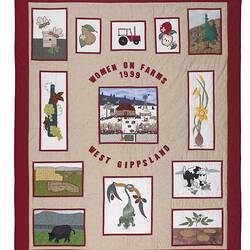My name is Joan Templar. Born in Braidwood, NSW and lived on a sheep and cattle property until I went away to boarding school. Returned home for a short period after my parent's marriage broke down and my father required a shearers cook. During my early childhood I was involved in farm work, from milking the house cow, shearing, drafting sheep, drenching sheep and cattle and the numerous other tacks that is involved in running a 2000 acre property.
I left home after my father remarried with the love of country life style still in my veins. I married and lived on the phosphate mining island, Ocean Island for 10 years. We returned to Australia when the mining ceased and settled in Pakenham. I was introduced to Women on Farms West Gippsland (WOFWG) through a friend and I have remained an interested member since. Through WOFWG I have attended the annual Women on Farms Gatherings, including to helping organize the 2009 Gathering.
1. How did you get involved with volunteering at Museum Victoria? Can you remember what your first day of volunteering was like?
Lyn Johnson is a member of WOFWG and was also involved in the Heritage Committee at the Museum Victoria. Lyn called for some of the members from WOFWG to volunteer to catalogue the Women on Farms Gatherings (WoFG) collection. Not having a clue what was involved I can remember my first day. First we taken into meet the man who is in charge of the volunteers for a small talk and an I.D. photo was taken. Liza Dale-Hallett was the curator who explained what was required with our computer work. I went home with lots of notes in an endeavour to remind me what was required a month later. I only volunteer one day a month.
2. What have been the highlights of working at Museum Victoria and can you tell us what sorts of things you have been working on?
I have found all the staff extremely friendly at Museum Victoria which makes volunteering enjoyable. Over the years I have often used my I.D. badge to enter IMAX, exhibitions and the museum itself, which I find a real bonus to volunteering. To date I have worked on the WoFG Memorial Plaque, which was my first project. Quite a learning curve for me, from the type of wood the plaque was made from to researching the names of the women whose names are on the plaque. My next project was identifying some of the many photos in the collection. This took many months as none of the photos collected had any details attached to them. Researching why the photos were taken, name the people in the photos, which Gathering the photo was related to, are just some of the research that to be carried out.
3. What is your favourite object in the WoFG collection? Please tell us why and little bit about it.
The collection includes many lovely objects, particularly the quilt which some of the WoFWG members designed and spent many hours together sewing the quilt. The quilt is made up of patches and each design depicts a farming scene. Another interesting item is the perpetual banner. Each year a new patch is added to the banner as a record of the town hosting the Gathering.
4. What is your favourite image in the WoFG collection? Please tell us why and little bit about it.
With so many photos and having to select one imagine is hard. I think my favourite image would be of photos of the group from WoFWG. As a group we catch a coach to the Gathering and it is mandatory to have a group photo taken each year. These images give a record of who attended the Gathering in a certain year.
5. Why is the history of the WoFG important? What can it tell future generations about rural Australia.
Rural life has changed so much since early settlement in Australia and collections like the WoFG details some of these changes. The collection only covers 20 years from 1990-2009, but during this time many changes have revolved. Droughts, floods, high and low stock and crop prices, but it mostly catalogues women involvement in farming. Over the years women's contribution to farming has become more recognised and are no longer seen as the 'little women in the kitchen'.
6. How is history celebrated at the WoF Gatherings?
Each Gathering women are invited to tell their life story. What better way to learn about the changes in farming then hear the stories first hand. These stories can cover subjects such as sporting achievements; losing one partner and having to carry on the farm by themselves. Other women will tell how they have set up a business away from the farm to help with costs of running the farm. Some stories are sad, others have funny moments but all stories but all the women chosen to tell their story all have some very interesting to say.
More Information
-
Keywords
-
Authors
-
Article types




